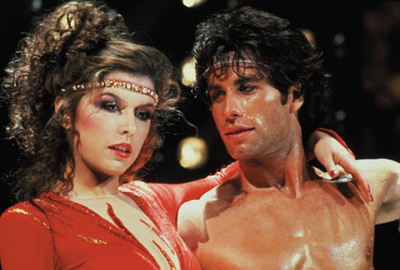Chapter Two
Staying Alive
By Brett Ballard-Beach
July 21, 2011
What the PG-marked Staying Alive resembles/feels like is a heavily sanitized version of Fever, or more accurately, a sequel to the bowdlerized PG-rated version of Fever. I have never seen this 1979 re-issue, but I can’t imagine it in any way improves upon what director John Badham and screenwriter Norman Wexler successfully produced two years earlier. The characters in Fever toss off casual sexist comments, racist attitudes and profanities as if they were second nature. They drink to get drunk, snort to get high, engage in ridiculous behavior, exhibit stupid tendencies and view women in one of two modes: as whores, or fast on their way to becoming whores (no Madonna alternatives here to complicate things.)
It may be hard for some to see the forest for the white suits, tight pants, strobe lights and disco music, but Saturday Night Fever plays like a dispassionate anthropological study more than anything. It observes the “Tribal Rites of the New Saturday Night” - as the magazine piece the film was inspired by was titled - but it does not condemn or condone, criticize or praise, condescend to nor elevate its characters. Tony Manero has more insight and a little more self-awareness than most of his posse, but at times it is just enough to get him into and not out of trouble. It is telling of the film’s focus that the “big dance-off” is not the climax but that the fallout from that competition is.
Fever may be the only Hollywood film that concludes with a man asking a woman if she will be his friend. From a cultural standpoint, Tony Manero is a man on the verge of the “Me Decade” who finds it more compelling to wonder about everybody else. Staying Alive works tirelessly to rectify those deeper concerns, to the point where the film’s moral message resides somewhere between conflicted and hypocritical.
In Staying Alive, Tony has a long-time girlfriend Jackie, also a fellow dancer and singer in a bar band, who puts up with his bullshit with the patience of a saint. He leers at other girls constantly and in one of only two actions that could honestly be called plot developments in the film, he cheats on her repeatedly with a haughty British dancer who is supposed to be desirable because she is cold and unapproachable (she can even do without him after she has been approached, in the Biblical sense). To see Tony acting like an asshole and a wounded puppy-dog simultaneously is disheartening and confusing. Casting future soap opera and nighttime television mainstay Finola Hughes as Laura the man-eater showed good sense, but the film really belongs to her rival for Tony’s affection, played by Cynthia Rhodes.
Rhodes didn’t go on to a lot after this, in part because she married singer Richard Marx in 1989 and retired from the entertainment scene shortly thereafter, but she did also star in the third highest grossing film of 1983 (more on that shortly) and notched a top 10 pop hit with the group Animotion before the decade ended. Whether through her charisma, inherent likability, or natural talent, she somehow imbues Jackie with strength even when forgiving Tony for the umpteenth time. Instead of wanting to knock sense into her, we can almost buy that Tony might be redeemable (he’s not) because Jackie must see something in him.
Tony and Jackie get cast in the chorus of the aforementioned Satan’s Alley alongside lead Jackie - side note: After perusing the results of a Google search, I must disclaim this Satan’s Alley has no connection to the fake movie featured in Tropic Thunder, but consideration of this throws the aggressively hetero Staying Alive into murky sexual waters indeed - and Tony finagles his way into the lead role. This leads to the extended climax in which the audience (on screen) and the audience (you and I) are subjected to what could best be titled “Yo Adrian! Check Out the MTV Influences in my Musical Number!”
Quick cuts? Check.
Bombast? Check
S&M costuming and choreography lewd and suggestive enough to make you feel dirty, but not dirty enough? Check.
Out-of-control fog machine? Check.
‘80s corporate schlock rock on the soundtrack? Check. (More on that in a minute.)
The scenario laid out by Stallone (and co-writer Wexler, returning from the first film) suggests that what is called for to end the story is something as rousing as Balboa vs. Creed or Balboa vs. Lang, a precursor to John Rambo finally winning the Vietnam War two years later. He dreams up the Broadway show as pulverizing entertainment, extreme hoofing, the musical as literal war. Tony Manero fights his way through whips and chains and blood and scores of chorus dancers (and oh so much fog) until he emerges like the last warrior of The Great White Way, balancing Jackie on just one hand in the musical’s finale, face grimaced, muscles buckling, look of intensity so strong it suggests he would take the ’77 Tony Manero and break him over his knees.
Continued:
1
2
3
|
|
|
|




